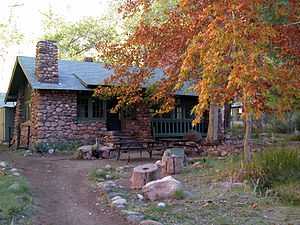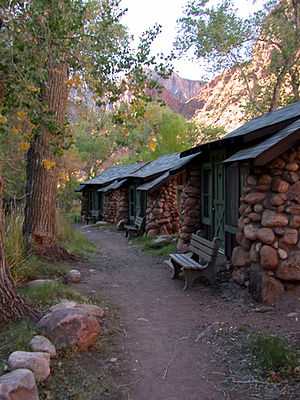Phantom Ranch
Phantom Ranch is a resort village within Grand Canyon National Park in Arizona. It is located on the north side of the Colorado River near its confluence with Bright Angel Creek and Phantom Creek. Built in 1922, Phantom Ranch is a member of Historic Hotels of America, the official program of the National Trust for Historic Preservation.[1]

History
The site where the ranch is now located was used by Native Americans; pit houses and a ceremonial kiva dating from about 1050 have been found there. The earliest recorded visit by Europeans took place in 1869, when John Wesley Powell and his company camped at its beach. Prospectors began using the area in the 1890s, using mules to haul their ore. At the turn of the 20th century, the founders of the Grand Canyon Transportation Company began a project to exploit its tourism potential; they hired a crew to improve the trail from Phantom Ranch to the Canyon's North Rim. President Theodore Roosevelt traveled down the canyon to the camp during a hunting expedition in 1913; in honor of this visit, the site became known as Roosevelt Camp.
Roosevelt's enthusiasm for the Grand Canyon helped lead to its incorporation into the National Park System in 1919. The Fred Harvey Company was granted the concession for the camp in 1922; the company hired the American architect Mary Colter to design permanent lodging. Mary Colter suggested that its name be changed to Phantom Ranch.[2] Construction presented a major challenge: all the building materials except rock had to be hauled down by mules. Meeting the challenges at this and other national parks led to the architectural style known as National Park Service Rustic, which features native stone, rough-hewn wood, large-scale design elements, and intensive use of hand labor.
During the Great Depression in the 1930s, the Civilian Conservation Corps made a number of improvements to the ranch and its access trails. The 1920s and 1930s saw its popularity grow, and it was visited by many wealthy and notable guests. The Fred Harvey company made it a point to hire young, attractive, well-educated, and adventurous women to staff the resort.
As the Grand Canyon's popularity grew, so did Phantom Ranch's; during the weekend of Easter in 1964, about 1,000 people appeared with the intention of spending the night there. The National Park Service then instituted a permit system for overnight stays at the ranch.
Phantom Ranch in the 21st century
The ranch continues to be one of the most popular destinations in the national park system; its accommodations are often sold out for a year in advance.
The site now includes cabins, two dormitories each for men and women, a restaurant (serving only people who book meals ahead of time), a mule corral, emergency medical facilities, a ranger station, the Bright Angel Campground, a beach that is frequently visited by Colorado River rafters, and a heliport. Cottonwood trees line the creeks and shade the buildings. The only modes of access to the ranch are foot trails (also used by mules) and the Colorado River. The North Kaibab Trail leads 14 miles to the North Rim. The 9.3 mile trail to the South Rim follows the River Trail for two miles and then climbs the Bright Angel Trail to Grand Canyon Village. The two trail bridges near the ranch are the only Colorado River crossings within a 200-mile span.[citation needed]
While Phantom Ranch has no official mail service (unlike Supai, Arizona[3]), concessionaires have traditionally transported letters and postcards via mules. Packages are excluded from this "mail" service.[4][5]

Geography
Phantom Ranch's elevation is 2,460 feet; that is about 4,800 feet lower than the South Rim and about 5,800 feet lower than the North Rim. The average daily high and low temperatures are 106/78°F (41/25°C) during July and 56/36°F (13/2°C) in January. This represents a wide differential from temperatures at the top of the Grand Canyon; at the South Rim, the average daily high and low temperatures are 84/54°F (29/12°C) in July and 41/18°F (5/-8°C) in January. The South Rim averages 58” (147 mm) of snow, and Phantom Ranch less than 1” (25 mm). The riparian zone at the ranch is subject to invasion by non-native species such as tamarix, and volunteers are at times invited to help maintain the original biome by removing them.
The ranch is located at 36°06′18″N 112°05′40″W / 36.10500°N 112.09444°W.
References
- ↑ Phantom Ranch, a Historic Hotels of America member. Historic Hotels of America. Retrieved January 28, 2014.
- ↑ Berke, Arnold: "Mary Colter: Architect of the Southwest", page 118. Princeton Architectural Press, 2002. 156898345X
- ↑ United States Postal Service. "History of the United States Postal Service 1775-1993". USPS. Archived from the original on 2006-08-22. Retrieved 2006-08-26.
- ↑ "No more care packages for Phantom Ranch". Arizona Daily Sun. 2013. Retrieved 2013-06-12.
- ↑ "Package Delivery to Phantom Ranch Discontinued". River Runners For Wilderness. 2012. Retrieved 2013-06-12.
Further reading
Thybony, Scott (2001). Phantom Ranch. Grand Canyon, AZ: Grand Canyon Assn. ISBN 978-0-938216-76-6. – This 32-page book reveals the ranch's history and the people who made that history. Also touches on the flora and fauna of Grand Canyon. The author is an archeologist and former river guide.
External links
| Wikimedia Commons has media related to Phantom Ranch. |
- Grand Canyon official website
- History of Phantom Ranch
- National Park Service Rustic Architecture
- Temperatures at the Grand Canyon
- The history of the Fred Harvey Hotels
Coordinates: 36°06′18″N 112°05′43″W / 36.10500°N 112.09528°W